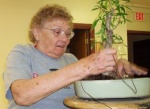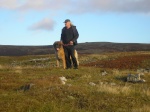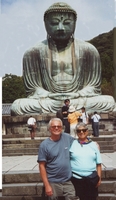How to View an Exhibit
+5
GaryWood
wabashene
JimLewis
chris
bonsaisr
9 posters
Page 1 of 1
 How to View an Exhibit
How to View an Exhibit
I have a little space in my next newsletter, which announces our upcoming exhibit. I would like to include a short article on how to view a bonsai exhibit. Couldn't find anything on Google. Anybody got something on the subject?
Thanks.
Iris
Thanks.
Iris

bonsaisr- Member
 How to View an Exhibit
How to View an Exhibit
To clarify, I don't need information on how to create an exhibit. I would like something on what people should look for or pay attention to when they visit a bonsai show.
Iris
Iris

bonsaisr- Member
 Re: How to View an Exhibit
Re: How to View an Exhibit
OK so you get to the show sometimes after traveling for hours, then you spend the day at the show, on the way home you ask and talk about the trees etc that were shown!
What became obvious to me early on in these visits was that there were very few involved in the after show talk.
The reason for this is they were just not looking closely at the exhibition, they could tell you all the trade stands and the prices of the trees etc on sale (even one member a few years ago stating if there was not trade stands at a show he would not be going!).
One thing I ask is that you respect the trouble that the exhibitors have gone to to put the trees, stones etc on the tables, (what is involved in this is to much for this thread).
So I started to set Questions on the way to the shows,
1 What is your favourite tree in the show and why
2 What is your favourite accent and why
3 What tree suited its pot best
4 what trees didn't you like and why
I still ask all these questions but along with this we set a time in the day to" Walk the Show" together, this is an idea I had from Tony Tickle ( thanks Tony). This is always a great hour or so and involves any one at the show including people from other clubs who are more than welcome bringing a different eye to the tour, this is not in any way a chance to say anything bad about the trees, this is to look at every exhibit and to talk about what people like or dislike about them, it is to make sure that everyone involved look at everything and therefore giving the exhibitor and exhibit the respect they deserve.
This is my way to view a show
Regards Chris
What became obvious to me early on in these visits was that there were very few involved in the after show talk.
The reason for this is they were just not looking closely at the exhibition, they could tell you all the trade stands and the prices of the trees etc on sale (even one member a few years ago stating if there was not trade stands at a show he would not be going!).
One thing I ask is that you respect the trouble that the exhibitors have gone to to put the trees, stones etc on the tables, (what is involved in this is to much for this thread).
So I started to set Questions on the way to the shows,
1 What is your favourite tree in the show and why
2 What is your favourite accent and why
3 What tree suited its pot best
4 what trees didn't you like and why
I still ask all these questions but along with this we set a time in the day to" Walk the Show" together, this is an idea I had from Tony Tickle ( thanks Tony). This is always a great hour or so and involves any one at the show including people from other clubs who are more than welcome bringing a different eye to the tour, this is not in any way a chance to say anything bad about the trees, this is to look at every exhibit and to talk about what people like or dislike about them, it is to make sure that everyone involved look at everything and therefore giving the exhibitor and exhibit the respect they deserve.
This is my way to view a show
Regards Chris

chris- Member
 Re: How to View an Exhibit
Re: How to View an Exhibit
For the uninformed public who might attend it always helps to have club members or exhibitors standing by and offering to "answer any questions you might have" (even "How Old Is It?). A badge or name tag identifying these people and mention of them in a printed program near the entry also might help.

JimLewis- Member
 Re: How to View an Exhibit
Re: How to View an Exhibit
Hello Iris ,
These are the sort of things people inc me look at
General character
Overall impression, young, mature, old, distressed, tall ,short, masculine/feminine etc. etc.
Design,
In keeping with overall impression. eg. pointy top on an old image is out of place or ditto straight characterless branches on a twisty trunk
Taper/ height ratio,
Good taper provides a more convincing . Height to trunk base ratio in the 6:1 - 10:1 range (bunjin excepted)
Nebari,
Good surface root spread reinforces maturity and solidity
Branches,
In keeping with overall image. Distinct spacing and placement evident
Pot
Clean & suitable for general character of tree and correct depth/width, delicate tree- delicate pot, robust tree-robust pot
Soil
Clean, tidy & weed free
Techniques
Tidy and effective wiring, natural looking dead wood, well disguised pruning scars
Basically it should give the impression a large tree in a natural setting- but we all know that
Hope this is the sort of thing you're after.

Thks
TimR
These are the sort of things people inc me look at
General character
Overall impression, young, mature, old, distressed, tall ,short, masculine/feminine etc. etc.
Design,
In keeping with overall impression. eg. pointy top on an old image is out of place or ditto straight characterless branches on a twisty trunk
Taper/ height ratio,
Good taper provides a more convincing . Height to trunk base ratio in the 6:1 - 10:1 range (bunjin excepted)
Nebari,
Good surface root spread reinforces maturity and solidity
Branches,
In keeping with overall image. Distinct spacing and placement evident
Pot
Clean & suitable for general character of tree and correct depth/width, delicate tree- delicate pot, robust tree-robust pot
Soil
Clean, tidy & weed free
Techniques
Tidy and effective wiring, natural looking dead wood, well disguised pruning scars
Basically it should give the impression a large tree in a natural setting- but we all know that
Hope this is the sort of thing you're after.
Thks
TimR

wabashene- Member
 Re: How to View an Exhibit
Re: How to View an Exhibit
Iris, are you referring to trees in a show or how the trees are presented in a show context? Tim gave an excellent list for evaluating individual trees. In the context of a show, I look at how the trees are arranged with regard to seasonality, directional flow, size variation, texture contrast, color and the list goes on  I personally believe that a show should follow the "rules" of the most basic things we do in bonsai. An example; I've seen many, MANY shows where there is a line of trees on tables where there is no thought in enhancing the viewing audience, ten Junipers in a row, boring. Just as we do in three point display or a shohin box display, only expanded. A line that has flow from an individual tree starting it and one on the other end bringing it back. Seasonal interest in the middle, if that's the theme. What I typically see is show set-up as an afterthought when planing could greatly enhance viewing interest.
I personally believe that a show should follow the "rules" of the most basic things we do in bonsai. An example; I've seen many, MANY shows where there is a line of trees on tables where there is no thought in enhancing the viewing audience, ten Junipers in a row, boring. Just as we do in three point display or a shohin box display, only expanded. A line that has flow from an individual tree starting it and one on the other end bringing it back. Seasonal interest in the middle, if that's the theme. What I typically see is show set-up as an afterthought when planing could greatly enhance viewing interest.
Wood
Wood
GaryWood- Member
 Re: How to View an Exhibit
Re: How to View an Exhibit
I like all of Chris and Timr's ideas. One other thing I'd add to the questions is "which pot/tree/table combination works best for you and why".
Anything that encourages people to really take the exhibits in, study and evaluate the trees on show, work out why it is that some are supreme examples of the art and others fall short will enhance their understanding and pleasure.
One thing that I have found distracts me is carrying my camera, so I try to make a point of arriving as early as possible or staying late and reserving one of those times for taking pic's. Then I like to walk the show at leisure, on my own and repeat as Chris suggested with friend(s) discussing the exhibits. If you whizz around once snapping photo's as you go, you get very little time to take the trees in at all. This also helps you get better pictures as there will be fewer visitors getting in your way, or you in theirs!
For the uninitiated, it helps just to ask them to pick their favourite tree and place a number on a voting slip, so that you can work out the Publics Favourite Tree. They take appreciably longer in studying as they walk around.
Anything that encourages people to really take the exhibits in, study and evaluate the trees on show, work out why it is that some are supreme examples of the art and others fall short will enhance their understanding and pleasure.
One thing that I have found distracts me is carrying my camera, so I try to make a point of arriving as early as possible or staying late and reserving one of those times for taking pic's. Then I like to walk the show at leisure, on my own and repeat as Chris suggested with friend(s) discussing the exhibits. If you whizz around once snapping photo's as you go, you get very little time to take the trees in at all. This also helps you get better pictures as there will be fewer visitors getting in your way, or you in theirs!
For the uninitiated, it helps just to ask them to pick their favourite tree and place a number on a voting slip, so that you can work out the Publics Favourite Tree. They take appreciably longer in studying as they walk around.

Kev Bailey- Admin
 Re: How to View an Exhibit
Re: How to View an Exhibit
Hi Iris... The guest to an exhibit is offered an atmosphere created uniquely with each display in addition to a tone that should be harmonious among the displays. Take a glance at the entire exhibit, and decide a plan for viewing each bonsai that entrances your imagination. The coordinator of the exhibit will have created rhythm & flow but would expect each guest to find their own.
Don't assume your early favorite will touch your imagination most. Initiate conversation with viewers who seem engaged to share their experience. Resist labels of good, better, best in seeking the best of each exhibit. If there is a scroll, note the relation of the tree to the scroll & imagine the 'open space' between. Return to the tree to view it carefully & pay similar attention to the soil, pot & supporting table or board. From the bonsai follow the accessories on the table sequentially-- 1st accent (supporting bonsai), 2nd accent (supporting first accent), 3rd accent (supporting second accent).
Review the entire display at a glance to feel the atmosphere of the the scene & perhaps imagine something not explicitly shown, but felt.
If you recognize sensitive viewers, try to learn their impressions by listening and respectfully sharing.
I'd love to see an exhibition with you, Iris.
Don't assume your early favorite will touch your imagination most. Initiate conversation with viewers who seem engaged to share their experience. Resist labels of good, better, best in seeking the best of each exhibit. If there is a scroll, note the relation of the tree to the scroll & imagine the 'open space' between. Return to the tree to view it carefully & pay similar attention to the soil, pot & supporting table or board. From the bonsai follow the accessories on the table sequentially-- 1st accent (supporting bonsai), 2nd accent (supporting first accent), 3rd accent (supporting second accent).
Review the entire display at a glance to feel the atmosphere of the the scene & perhaps imagine something not explicitly shown, but felt.
If you recognize sensitive viewers, try to learn their impressions by listening and respectfully sharing.
I'd love to see an exhibition with you, Iris.

Chris Cochrane- Member
 Re: How to View an Exhibit
Re: How to View an Exhibit
Hi,
Take one idea you could try yourself later from each exhibit you attend.
Talk to the owner of the tree and source as much opinion relating to your chosen idea while still at the exhibit.
That way no matter what level of you appreciation, you will always return home with a positive attitude and not wishing to start your collection all over again.
Take one idea you could try yourself later from each exhibit you attend.
Talk to the owner of the tree and source as much opinion relating to your chosen idea while still at the exhibit.
That way no matter what level of you appreciation, you will always return home with a positive attitude and not wishing to start your collection all over again.

Jeremy- Member
 How to View an Exhibit
How to View an Exhibit
Thanks to everyone for your suggestions. Now I have to boil them down to half a column.
Iris
Iris

bonsaisr- Member
 Re: How to View an Exhibit
Re: How to View an Exhibit
Iris,
maybe they could read this:
http://walterpallbonsaiarticles.blogspot.com/2009/10/thoughts-about-viewing-bonsai-by-walter.html
maybe they could read this:
http://walterpallbonsaiarticles.blogspot.com/2009/10/thoughts-about-viewing-bonsai-by-walter.html

Walter Pall- Member
 How to View an Exhibit
How to View an Exhibit
Walter,
Your articles are fascinating. I love the one about the ugly oak. But they are rather advanced for most of the people who visit our show. Syracuse isn't Rochester.
Here is what I wrote to give out at our show, and about what I put in the newsletter.
HOW TO SEE A BONSAI SHOW
Welcome to the Bonsai Club of Central New York show. If you are not familiar with bonsai exhibits, here are some details to consider:
Were you pleased with the overall setup, layout, vendors, hospitality, information? If there is something you would prefer to be done differently, tell one of the exhibit hosts.
Are the trees arranged in an interesting display, far enough apart to view each one separately, but presented harmoniously?
Which display was your favorite? Why? Does the tree go with the pot and the stand? Does it give a convincing impression of a mature tree or a place you would like to visit?
If there is an ornament, figurine, or accent plant with a tree, is it subtle but interesting, and in scale with the bonsai? Does it help tell the story?
Were the labels useful? Is the print the right size? Is there additional information you would like to have? In a public exhibit, the names of individual exhibitors are not displayed, to avoid theft.
Was there a tree you especially didn’t like? What was wrong?
It is not relevant to ask the actual age of a tree. The important thing is how old it looks. However, you can inquire how long a tree has been in bonsai training. All the trees in this show have been in training a minimum of one year.
There is no such thing as a certain kind or species of bonsai tree. Most bonsai are small because of special gardening and training techniques, which you can learn at our meetings and from books. However, bonsai artists often seek out natural or cultivated dwarf varieties that lend themselves to bonsai training.
Enjoy the show!
Iris
Your articles are fascinating. I love the one about the ugly oak. But they are rather advanced for most of the people who visit our show. Syracuse isn't Rochester.

Here is what I wrote to give out at our show, and about what I put in the newsletter.
HOW TO SEE A BONSAI SHOW
Welcome to the Bonsai Club of Central New York show. If you are not familiar with bonsai exhibits, here are some details to consider:
Were you pleased with the overall setup, layout, vendors, hospitality, information? If there is something you would prefer to be done differently, tell one of the exhibit hosts.
Are the trees arranged in an interesting display, far enough apart to view each one separately, but presented harmoniously?
Which display was your favorite? Why? Does the tree go with the pot and the stand? Does it give a convincing impression of a mature tree or a place you would like to visit?
If there is an ornament, figurine, or accent plant with a tree, is it subtle but interesting, and in scale with the bonsai? Does it help tell the story?
Were the labels useful? Is the print the right size? Is there additional information you would like to have? In a public exhibit, the names of individual exhibitors are not displayed, to avoid theft.
Was there a tree you especially didn’t like? What was wrong?
It is not relevant to ask the actual age of a tree. The important thing is how old it looks. However, you can inquire how long a tree has been in bonsai training. All the trees in this show have been in training a minimum of one year.
There is no such thing as a certain kind or species of bonsai tree. Most bonsai are small because of special gardening and training techniques, which you can learn at our meetings and from books. However, bonsai artists often seek out natural or cultivated dwarf varieties that lend themselves to bonsai training.
Enjoy the show!
Iris

bonsaisr- Member
 Similar topics
Similar topics» mountain 40x15x10
» Gmelina hystrix - Indonesian flowering tree
» how about a bolcony pine, can I turn it into a bonsai?
» What shall I do with this?
» which is better for front view...
» Gmelina hystrix - Indonesian flowering tree
» how about a bolcony pine, can I turn it into a bonsai?
» What shall I do with this?
» which is better for front view...
Page 1 of 1
Permissions in this forum:
You cannot reply to topics in this forum






